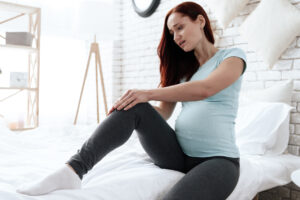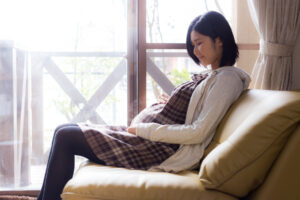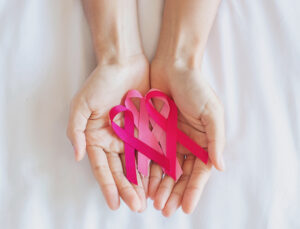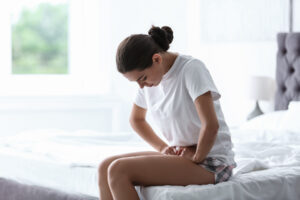
Becoming pregnant comes with a myriad of changes: mood swings and hormonal rollercoasters, as well as necessary—and many times unavoidable—changes to the body. Pregnant women have to be mindful of their diets, as well as their mental and physical condition. Another cause of concern during pregnancy is arthritis: can you develop arthritis after pregnancy? Does having arthritis affect your ability to become pregnant? Let’s explore some of these questions.
Developing Arthritis
There does not seem to be a direct correlation between becoming pregnant and developing arthritis either right after your pregnancy or later down the road. It is rare that women will develop rheumatoid arthritis after pregnancy, and this is only if the immune system attacks healthy joint tissue.
However, there are some elements of pregnancy that cause joint pain:
- Physical Demands of Pregnancy and Motherhood: Postpartum joint pain, or during pregnancy, can be caused because of the extra weight in your body. Your hips and knees may suffer because of it; sometimes your fingers too. Though most symptoms decline after childbirth, there is a chance they may stick around for longer and even develop into lifelong conditions. Applying ice packs and using compression bandages on areas that ache can help relieve the symptoms.
- Fluid Retention: As you may know, fluid retention is a common side-effect of pregnancy. This can also increase the risk of carpal tunnel syndrome, a condition that occurs when the median nerve in the hand is compressed. Fluid retention may also mean that fluid builds up the wrist, causing pressure on your hand nerves.
- Post-Partum Hip Pain: This is also known as Pelvic Girdle Pain (PGP), and it affects joints in the pelvic area. The most common cause of PGP is because the hips can become unstable during pregnancy. Its symptoms include pain in the pubic area, pain that seems to worsen with activity, radiating pain in your lower back, and popping sounds when you move your hips.
Pregnant with Arthritis
Generally speaking, you can become pregnant if you have arthritis. However, since certain medications can affect your baby or interfere with your ability to conceive, you should consult your doctor beforehand.
Symptoms of arthritis during pregnancy may worsen, as your body is carrying on extra weight. Added pressure on your spine can cause muscle spasms or numbness in your legs. Additionally, remember that sometimes pregnancy hormones change our perception of pain: as such, pain that was moderate before your pregnancy may be experienced as much higher when you are pregnant.
If you are taking medication for arthritis, consult your doctor on what medication is safe to continue, and which ones aren’t. Continue to be mindful of both medication and pain-reliever intake if you plan to breastfeed. Remember to exercise during pregnancy, so you can assist your body in promoting flexibility and muscle strength. If you are worried about the safety of your exercise routine when it comes to your baby, always consult a medical professional.
More
By Iris Farrou
05 Dec, 2021
Women's Health
Best gyns in Buffalo, Best OB practices in Buffalo, Best OBGYN Groups in Buffalo, Buffalo OBGYN, Chouchani MD, endometriosis, WNY OB-GYN, WNY Ob-gyn doctors, WNY OBGYN, women's health

If you have been diagnosed with endometriosis or may suspect you are included in the percentage of the female population that has it, you may be concerned about your fertility levels and/or conceiving and carrying to term. Endometriosis is very common and affects between 6% and 10% of the general female population. About 30%-50% of women with it are infertile, and about 25%-50% of infertile women have endometriosis.
Here are some options to consider if you are diagnosed with endometriosis and are interested in becoming pregnant:
Expert Assistance
It is possible that some surgical operations associated with the diagnosis and treatment of endometriosis may affect your ability to become pregnant, so if you haven’t yet undergone any surgical procedures, it would be a good idea to discuss the risks with your doctor. You may also want to consider working with a fertility specialist who will help you find out the contributing factors to your infertility and determine the severity of your disorder.
Improving your Chances
There is no current evidence that suggests medication can assist you in getting pregnant if you live with endometriosis. However, your doctor may instruct you to take progestins so you can increase the level of pregnancy hormones in your body. Another suggestion is to follow a healthy lifestyle so you can decrease the chances of inflammation in your body and help your baby thrive throughout a healthy pregnancy:
- Maintain weight that is healthy for your body type.
- Engage in moderate exercise in your daily life.
- Consume nutrient-dense foods.
Treatments
- Fertility medications are fairly common for women with endometriosis. These can range from progestin injections to fertility medications like Clophemene to help you produce 2-3 mature eggs.
- You may also undergo regular ultrasounds to determine the maturity of your eggs. At the appropriate time, your doctor can insert collected sperm to assist in conceiving.
- In vitro fertilization is also an option couples go for, whereby the egg is fertilized outside the body and then inserted into the uterus.
- If you have mild endometriosis, or your endometriosis has not affected your fallopian tubes, you may consider intrauterine insemination.
- A more costly option, and usually not covered by insurance, is to freeze your eggs. Endometriosis can affect your ovarian reserve, so this option helps if you want to try and become pregnant at a later time.
The good news is that many women living with endometriosis have managed to get pregnant using IVF, especially in cases of moderate or mild endometriosis. Though the chances are about 50% less than those of couples who use IVF due to other infertility reasons, many women with endometriosis are able to conceive and deliver a healthy baby. It is recommended that you start discussing your fertility options with your doctor even before you are thinking of getting pregnant.
Learn more about IVF: https://wny-obgyn.com/2022/03/ivf-step-by-step/
More
By Iris Farrou
30 Nov, 2021
Breastfeeding support
Benefits of breastfeeding, Best gyns in Buffalo, Best OB practices in Buffalo, Best OBGYN Groups in Buffalo, Buffalo OB-GYN, Buffalo OBGYN, Chouchani MD, WNY OB-GYN, WNY Ob-gyn doctors, WNY OBGYN, women's health
 The debate on whether breastfeeding or formula is better for a newborn baby may be alive and well, but the reality is that many mothers do choose to breastfeed. If you are thinking of breastfeeding your newborn or are already doing so, here is some advice on breast care and how to also take care of yourself in the process.
The debate on whether breastfeeding or formula is better for a newborn baby may be alive and well, but the reality is that many mothers do choose to breastfeed. If you are thinking of breastfeeding your newborn or are already doing so, here is some advice on breast care and how to also take care of yourself in the process.
Nutrition
While breastfeeding your baby proper precautions, nutrition, and attention to your body can enrich the experience of motherhood. Remember that nutrients travel through breastmilk into your baby’s body, so it is important to be aware of what you consume. Food, alcohol, and substance intake are often one of the first concerns all mothers have. You may be concerned about eating more food but consuming an extra 330 to 400 for nutrient-rich calories per day actually helps you have more energy and increases milk production.
You want to avoid alcohol, caffeine, and fish. Instead, try to focus on a protein-rich diet sourced from lean meat, vegetables, beans, fruits, vegetables, and whole grains. Eating iron as well as vitamin and calcium-dense foods ensures both you and your baby’s health. Vitamins play a key role in making sure proper nutrition thrives. If you are considering taking diet supplements or multivitamins, it is best to consult your health care provider beforehand.
If you follow a vegetarian diet, the same rules apply. Eat calcium, protein, and iron-dense foods. Try to opt for foods like plant protein, leafy greens, raisins, lentils, and whole grains. Quinoa is an excellent choice because it’s one of the only vegetarian complete proteins, meaning it has all nine essential amino acids that our bodies cannot self-produce.
Hydration
Consciously monitoring your hydration intake is as important as diet. When breast milk fluids are leaving your body, more fluid needs to go back in. Monitoring your urine color, smell and frequency are natural cues to know when to consume more healthy beverages; if something feels out of the ordinary, you need to change your fluid intake. Choose water over sugar-laden beverages and avoid caffeinated drinks. Caffeine can cause your baby to be agitated, and too much sugar can cause postpartum weight gain.
Breast Care
While breastfeeding, you also want to make sure you are allowing yourself to properly care for your nipples. An easy way to do that is by allowing some breast milk to dry on them. Breast milk has natural skin softening abilities and antibodies. If your doctor says it’s safe, take acetaminophen thirty minutes before breastfeeding to help relieve some of the pain. Start feeding your baby on the side of your breast that is less tender. Also, alternate sides and your baby’s position with each feeding. Let your nipples air-dry whenever possible and use hypoallergenic topical ointments to prevent dryness.
You can also apply cold compresses after feeding, and also provide your breasts with plenty of support. Cotton breastfeeding bras with non-elastic straps are a great option. If needed, wear a bra at night for additional support. Avoid washing your nipples with soap as it can dry them out more, or avoid using all-purpose lotions, creams, and bras with plastic lining. 
If you have symptoms that persist, such as increasing redness, puss, intense tenderness, or a fever over 101°F contact your doctor or health care provider.
More
By Iris Farrou
20 Nov, 2021
Prevention
Best gyns in Buffalo, Best OB practices in Buffalo, Best OBGYN Groups in Buffalo, Buffalo OB-GYN, Buffalo OBGYN, Chouchani MD, WNY OB-GYN, WNY Ob-gyn doctors, WNY OBGYN, women's health
 If you have had women in your family with ovarian cancer, you may very well be concerned that it’s something hereditary. Genetic testing is available for ovarian cancer, though the CDC notes that most types of ovarian cancer are not caused by inherited mutations, so genetic testing may not help most women. However, genetic counseling can help determine whether you and your family are likely to have a mutation that should get tested.
If you have had women in your family with ovarian cancer, you may very well be concerned that it’s something hereditary. Genetic testing is available for ovarian cancer, though the CDC notes that most types of ovarian cancer are not caused by inherited mutations, so genetic testing may not help most women. However, genetic counseling can help determine whether you and your family are likely to have a mutation that should get tested.
The following scenarios are of higher risk:
- If you’ve had a significant family history ovarian cancer
- In case of moderate family history of ovarian cancer and are of Ashkenazi Jewish or Eastern European ancestry
- If you have personal history of breast cancer and meet criteria related to age of diagnosis, type of cancer, presence of other cancers, cancer in both breasts, ancestry, and family health history
- Having a personal history of ovarian, fallopian tube, or primary peritoneal cancer
- Carrying a known BRCA1, BRCA2, or other inherited mutation in your family
What are the BRCA Genes?
The breast cancer 1 (BRCA1) and breast cancer 2 (BRCA2) genes are the genes most commonly affected in hereditary breast and ovarian cancer. Those genes are meant to protect you from getting certain cancers, but mutations may prevent them from working properly. If you inherit one of these mutations, you are more likely to get breast, ovarian, and other cancers.
How does genetic testing work?
The BRCA gene test is a blood test that uses DNA analysis to identify harmful mutations in either one of the two breast cancer susceptibility genes. You could also do a multigene panel, which looks for mutations in several genes simultaneously. If there is someone in the family who has had breast, ovarian, or other BRCA-related cancer, they should be the first to get tested. If that is not possible, then an unaffected person can get the test done. Keep in mind that in this case the results may not be as helpful.
What do the results mean?
Positive: this you have a mutation in either BRCA1 or BRCA2, so you are at a much higher risk of developing breast cancer or ovarian cancer. Someone who doesn’t have the mutation is at a much lower risk. However, a positive result is NOT a guarantee that you will develop cancer. Rather, it cautions you to get tested more frequently and to consider procedures and medications to minimize your cancer risk.
Negative: it means a BRCA gene mutation was found but assessing your cancer risk is still difficult. The test result is a “true negative” only if it finds that you don’t have a specific BRCA mutation that’s already been found in a relative. Unfortunately, even with a negative result you still have the same risk of cancer as the general population.
There is also the possibility of getting an uncertain result, which means a mutation in one of the genes was found, but whether that specific mutation causes cancer is undetermined. Researchers continue to develop medical practices to prevent cancer and treat patients successfully, and within the means of science it is definitely advised to do what you can to keep yourself and your family safe, as well as take precautions.
More
By Iris Farrou
10 Nov, 2021
Menstruation
Best gyns in Buffalo, Best OB practices in Buffalo, Best OBGYN Groups in Buffalo, Buffalo OB-GYN, Buffalo OBGYN, Chouchani MD, WNY OB-GYN, WNY Ob-gyn doctors, WNY OBGYN, women's health
 The monthly phenomenon of menstruation is a reality for many women: legs and breasts get swollen, cramps arrive, and the uterine lining does its monthly job. Though in our adult years we are more or less prepared for this arrival, there was a time when we were expecting our periods like a rite of passage into womanhood. The time for the Very First Period! It may have been years since yours, but you also may have a young teen in your life who is now where you once were, waiting for her first menstrual cycle to make its appearance.
The monthly phenomenon of menstruation is a reality for many women: legs and breasts get swollen, cramps arrive, and the uterine lining does its monthly job. Though in our adult years we are more or less prepared for this arrival, there was a time when we were expecting our periods like a rite of passage into womanhood. The time for the Very First Period! It may have been years since yours, but you also may have a young teen in your life who is now where you once were, waiting for her first menstrual cycle to make its appearance.
How can you be prepared to have a first period conversation?
Whether it is your daughter, niece, younger sister, a cousin, or a younger friend, you can share some simple facts with the young woman in your life who may have questions about her menstrual cycle. Most people start their periods around the age of 12, but a little earlier or later is not unusual. With puberty, our bodies start becoming capable of reproduction: first the breasts start developing, and a few years later menstruation begins.
Your period may knock on your door without any warming, or you may experience pre-menstrual syndrome (the infamous PMS). Some common symptoms include acne, breast swelling and soreness, abdominal bloating, back pain, and clear or vaginal discharge. You may also find yourself feeling more tired than usual, as well as more irritable or emotional. Constipation and diarrhea are also not uncommon.
When it’s Time
It’s always good to be prepared and awaiting the arrival of your period is no exception. Many people carry a period kit in their bags, which can include clean underwear, a pad or a tampon, wipes, and pain relievers. If you have that with you, great! But sometimes we’re not prepared… worry not, female ingenuity goes a long way—you can make a pad out of toilet paper! Take at least ten pieces of TP and fold them one over another to form a rectangular. Place this in the middle part of your underwear and wrap some TP around it on the opposite direction, tucking in the end of it on the rectangular piece to hold it in place. Though far from perfect, this is still a way to protect your clothing and feel a little more comfortable.
What about the Pains?
Period cramps happen because the uterine lining has prepared itself for a fertilized egg, but hasn’t received any, so it’s now thickened and discharging itself. You can help alleviate the pains by taking some ibuprofen or naproxen. If you have any allergic reactions to medications, be careful which one you choose! You can also use a warm pad on your belly or take a hot shower. Many women find it helpful to walk around some or consume more water than usual.
It may be super daunting at first but remember that the more you learn your body’s symptoms as time goes by, the more prepared you will be and the easier it will get. And if you’re reading this to give advice to a younger menstrual sufferer, remember that your personal experience goes a long way!
More
By Iris Farrou
30 Oct, 2021
Pregnancy
Best gyns in Buffalo, Best OB practices in Buffalo, Best OBGYN Groups in Buffalo, Buffalo OB-GYN, Buffalo OBGYN, Chouchani MD, Healthy pregnancy, WNY OB-GYN, WNY Ob-gyn doctors, WNY OBGYN, women's health

Even though many high school teachers had teenagers convinced they could get pregnant simply by having sex (and there’s definitely merit to that), in adulthood things can get a little more complicated. If you and your partner are trying to get pregnant through natural insemination, there are a few factors you may want to take into consideration in order to increase your chances of conceiving.
First Things First would be to become familiar with your cycle so you can determine whether it is a regular one (every 28 days) or an irregular one (shorter or longer). That will also help you find out when you may be ovulating. You can use apps to help you track your cycle, as well as your symptoms on the days leading up to menstruation and after. You can also notice symptoms such as an increase in body temperature and more vaginal secretions on the days leading up to your ovulation.
Knowing when you ovulate means you can determine your most fertile days each month. On a regular cycle, this would be 2 weeks before you get your period. It can be a little more difficult to predict that on an irregular cycle, but it is usually 12-16 days before you menstruate. You can better determine this with the help of home ovulation prediction kits, which test urine for luteinizing hormone, a substance whose levels increase each month during ovulation.
The short fertility window spans 5 days before ovulation begins and the 1st day of it, and that’s when the chances of conceiving are even higher. Many couples wonder if it would be best to have sex every day during that window, and the short answer is: yes! The highest rates of pregnancy occur in coupled who have sex regularly, and near or on the time of ovulation.
Knowing the medical information about your body is definitely helpful, as is learning to recognize where your cycle is and being in tune with it. If you have an IUD, tied tubes, or feel that you need assistance in planning a pregnancy, you can always consult an expert and be in touch with your doctor. However, you may also want to take into consideration some of the following factors that contribute to conceiving:
- Maintaining a healthy weight can help, as excess body fat has been found to produce more estrogen, which can interfere with ovulation. Underweight women can also suffer from irregular periods or could also stop ovulating.
- Eating healthy foods that contribute to preparing a woman’s body for pregnancy by providing adequate calcium, protein and iron, and folic acid. Try to avoid foods that are high in mercury, as it has been found to enter women’s bloodstream and has been linked to negatively affecting a baby’s development.
- Cutting down on alcohol and smoking are very important factors in not only maintaining your general health, but also ensuring your body is a healthy home for a fetus.
Keep in mind that stress can be a huge factor when trying to conceive. Lots of couples face heightened stress and anxiety once they embark on the journey of getting pregnant, which can lead not only to intimacy issues, but also affect a woman’s cycle and throw it all off-balance. Remember this may not be an easy process and being supportive of each other as well as seeking help when needed are key to remaining healthy.
More
By Iris Farrou
19 Oct, 2021
Breast health, Prevention
Best gyns in Buffalo, Best OB practices in Buffalo, Best OBGYN Groups in Buffalo, Buffalo OBGYN, Chouchani MD, WNY OB-GYN, WNY Ob-gyn doctors, WNY OBGYN, women's health, women's health tips
 Along with the abundance of pumpkin spiced lattes and corn mazes around the country, October is also the month that brings us a lot of pink in honor of Breast Cancer Awareness. Approximately 1 in 8 women in the U.S. are afflicted, and more than 2 million women were diagnosed with breast cancer in 2020. Chances are, you already know someone who has been affected by this type of cancer. Though educating yourself on prevention and self-care techniques when it comes to it is of high importance, there are also some ways in which you can join the global effort for awareness.
Along with the abundance of pumpkin spiced lattes and corn mazes around the country, October is also the month that brings us a lot of pink in honor of Breast Cancer Awareness. Approximately 1 in 8 women in the U.S. are afflicted, and more than 2 million women were diagnosed with breast cancer in 2020. Chances are, you already know someone who has been affected by this type of cancer. Though educating yourself on prevention and self-care techniques when it comes to it is of high importance, there are also some ways in which you can join the global effort for awareness.
How can I become involved?
- The pink ribbon is the international symbol for breast cancer, and pink has been associated with promoting awareness of it, as well as the efforts made to support women suffering from breast cancer. Wearing pink or adorning your outfit with a pink ribbon is an easy way to showcase support!
- Volunteering locally or nationally is also a good option, and the American Cancer Society (ACS) runs many programs that you can join: Relay for Life, Road to Recovery, and Making Strides Against Breast Cancer are some of them. You can also join one of the many Komen Race for the Cure events nationwide for another fundraising opportunity.
- Share facts and statistics whenever possible. You can do that in social conversations if the subject is brought up, in support of breast cancer survivors, with your coworkers, or with your kids as well if they are old enough to understand.
What are some basic facts I can share?
The National Breast Cancer Foundation and the American Cancer Society are great resources to learn more about breast cancer, access the latest news and statistics, and keep up with the latest scientific discoveries around it. These resources can back up the following US-specific facts:
- Apart from skin cancers, breast cancer is the most common among women
- 1 out of 8 women will receive a breast cancer diagnosis in her lifetime
- Every 2 minutes on average a woman in diagnosed with breast cancer
- There are over 3.8 billion breast cancer survivors
- 63% of breast cancer cases are diagnosed at a localized stage, for which the 5-year survival rate is 99%
How can I lower my risk?
Though there is no sure way to prevent breast cancer and some of the factors may be outside of your control, such as being born female and growing older, here are some basic actions you can take to lower your risk of breast cancer.
- Get regular mammograms to keep tabs on the health of your breasts. Many clinics offer free mammograms in October, so you can take advantage of this opportunity and urge your friends to do the same. Support them, go with them to the appointment, and lead by example.
- Limit alcohol or avoid it: even low intake of alcohol has been linked to increased chances of getting breast cancer, so try to limit it to 1 alcoholic drink a day.
- Maintain healthy weight: especially after menopause, it is important to maintain a healthy weight by watching your diet and exercising regularly, as weight gain and increased body weight have been linked to increased chances of breast cancer.
More
 If you have heard the word, you probably know endometriosis comes with pain. The endometrium is tissue that lines the inside of your uterus. In the case of endometriosis, tissue similar to endometrium grows on the outside of your uterus, involving your ovaries, fallopian tubes, and the tissue lining your pelvis. When this occurs, the endometrial-like tissue acts like the inside of your uterus on each menstrual cycle: it thickens, breaks down, and bleeds. However, it has no way outside of your body, so it is trapped and leads to excessive pain.
If you have heard the word, you probably know endometriosis comes with pain. The endometrium is tissue that lines the inside of your uterus. In the case of endometriosis, tissue similar to endometrium grows on the outside of your uterus, involving your ovaries, fallopian tubes, and the tissue lining your pelvis. When this occurs, the endometrial-like tissue acts like the inside of your uterus on each menstrual cycle: it thickens, breaks down, and bleeds. However, it has no way outside of your body, so it is trapped and leads to excessive pain.
What else happens?
If endometriosis has moved to the ovaries, cysts called endometria may form. As a result, surrounding tissue becomes irritated causing scar tissue and adhesions. It is possible that these adhesions can cause pelvic organs to stick to each other.
What are the symptoms?
One of the first symptoms of endometriosis is extreme pain during menstruation, far more intense than regular period cramps. However, the amount of pain is not a good measure for how severe your case of endometriosis may be: you can have a serious case of it with little to no pain, or a mild case with a lot of pain. Pain that’s associated with endometriosis may become worse with time, and the following symptoms often accompany it:
- Painful periods for extended time: pelvic pain and cramping may begin before your period and extend for days after it, coupled with abdominal pain and lower back ache
- Pain during or after intercourse is common with endometriosis
- Pain with bowel movements or urination
- Bleeding excessively during your period, or bleeding in between periods
- Infertility is also associated with endometriosis, as the condition is often found when women seek fertility treatments
Some other symptoms of endometriosis may include fatigue, diarrhea, constipation, and bloating or nausea.
What causes it?
Some of the most common causes associated with endometriosis are:
- Retrograde menstruation: when menstrual blood containing endometrial cells flows back into the fallopian tubes and into the pelvic cavity, not out of the body
- Transformation of peritoneal cells: when cells that line the inside of your abdomen become endometrial-like cells due to hormones or immune factors
- Embryonic cell transformation: when embryonic cells turn into endometrial-like cells during puberty
- Immune system disorder: when your body would not recognize and destroy endometrial-like tissue as a threat that is growing outside of your uterus
What are some of the available treatments?
Treatments depend on how severe your case of endometriosis is, and medication is taken as a first approach, with surgery following in extreme cases.
- Pain medication to ease menstrual cramps
- Hormonal contraceptives to control the hormones responsible for the buildup of endometrial tissue each month
- Progestin therapy can stop menstrual periods and the growth of endometrial implants
- Gonadotropin-releasing hormone (Gn-RH) agonists and antagonists block the production of ovarian-stimulating hormones, thus lowering estrogen levels and preventing menstruation, and leading to endometrial tissue shrinking
- Aromatase inhibitors is another way to reduce the amount of estrogen in your body
More
By Iris Farrou
30 Sep, 2021
Parenting
Best gyns in Buffalo, Best OB practices in Buffalo, Best OBGYN Groups in Buffalo, Buffalo OB-GYN, Buffalo OBGYN, Chouchani MD, WNY OB-GYN, WNY Ob-gyn doctors, WNY OBGYN, women's health
 Co-sleeping is the practice of sleeping with your newborn baby. There are many schools of thought and opinions on the safety, psychological effects and risks associated with the practice. Reviewing factual studies and professional resources on co-sleeping highlights that wanting to sleep with our infants and young children is perfectly natural, and only increases the risk of SIDS by 0.004%. When compared to the 0.006% chance of an infant dying from SIDS alone in their crib, the numbers speak for themselves.
Co-sleeping is the practice of sleeping with your newborn baby. There are many schools of thought and opinions on the safety, psychological effects and risks associated with the practice. Reviewing factual studies and professional resources on co-sleeping highlights that wanting to sleep with our infants and young children is perfectly natural, and only increases the risk of SIDS by 0.004%. When compared to the 0.006% chance of an infant dying from SIDS alone in their crib, the numbers speak for themselves.
Basic Benefits
Western culture has a history of separating mothers and babies at night, compared to other parts of the world that encourage co-sleeping more. As most mother know, sleeping separately from the baby leads to many sleepless nights for all members of the family, physical exhaustion for the caretakers, and of course a disruption of the sleeping cycle that transfers over to the next day.
Though many may believe that adult beds are not safe for the baby—and there is merit to that opinion—what the other school of thought boils this down to is the way in which the mother’s body cocoons the infant to protect it while sleeping. Similar to that is the positioning of the mother’s body when breastfeeding: she bends to form a protective shell around her baby. Mother and infant heartbeats and breathing both slow. The mother’s heartbeat soothes her infant, and the carbon dioxide the mother breathes out stimulates her baby’s breathing.
When co-sleeping, these same positive effects occur, and studies show that the babies move far less when sleeping with their mother than sleeping in their cribs alone, where they tend to toss and turn all through the night.
Tips for safe co-sleeping include:
- Guardrails to prevent the baby from falling off the bed.
- Position the baby adjacent to the mother instead of between the mother and father.
- Large beds, king-sized in particular, allow for plenty of space for safe co-sleeping.
- Make sure to place the baby on their back while sleeping.
- If placing the baby in your bed isn’t possible, a crib next to the bed keeps the baby at arm’s reach.
Do not co-sleep with your baby or young child if you are under the influence of alcohol or any drug, including sleeping medications or sedatives. Also, if you’re overly exhausted, avoid co-sleeping and breastfeeding on extremely soft surfaces to not accidentally cut air flow to your child. If you are extremely obese or the child’s babysitter, co-sleeping is highly advised against.
Behavioral and cognitive development outcome studies also show that co-sleeping is not only safe and healthy but promotes healthier minds and bodies while children grow as well. Consult your GP or OBGYN if you have any questions or concerns about co-sleeping, or for individualized advice.
More
By Iris Farrou
21 Sep, 2021
Sexual health
Best gyns in Buffalo, Best OB practices in Buffalo, Best OBGYN Groups in Buffalo, Buffalo OBGYN, Chouchani MD, WNY OB-GYN, WNY Ob-gyn doctors, WNY OBGYN, women's health, women's health tips
 Most couples are familiar with the use of lubricants when being intimate with each other, and many women may even use them on their own. Lubricants are typically essential in every sexually active household, and with so many personal gels and moisturizers out there to choose from, which ones are truly the healthiest for our vaginas and their pH balance?
Most couples are familiar with the use of lubricants when being intimate with each other, and many women may even use them on their own. Lubricants are typically essential in every sexually active household, and with so many personal gels and moisturizers out there to choose from, which ones are truly the healthiest for our vaginas and their pH balance?
It’s a common myth that water and silicone-based lubricants can disrupt vaginal pH balance and/or cause infections. The amount of acidity or alkalinity in a water-based environment, known as pH, is best between 3.5 and 4.5. Comparatively, the pH of semen is 7.0 to 8.5, and rectal pH is around 7.0. Our personal and partner’s hygiene is pivotal to helping keep our pH balance in check, especially when there are different pH balances involved.
Choosing a Lubricant
There are so many new lubricants on the market claiming to be natural and organic, it can sometimes feel overwhelming. You may be wondering, “are they really better for me?” If you have sensitive skin in your vaginal area or are prone to bacterial vaginosis (also known as Candida bacteria), natural and organic may be the way to go. Here are some of the best available to keep everything feeling fresh down there:
- Aloe Life Personal Gel Moisturizer Unscented
- Nuvia Organics Evening Primrose Oil
- Sustain Organic Lubricant
- H2OH! Water Based Lubricant
- Good Clean Love Almost Naked Organic Personal Lubricant
These are just a few of the best rated, healthy, and balancing personal moisturizers on the market. There are even brands of olive oil that are specifically for lubrication! However, since this is a very personal matter, you should always choose carefully based on how your body is experiencing different elements. Some women are extremely sensitive to oil-based lubricants, so if that sounds like you, it is advisable to go for a water-based one. Additionally, some may be sensitive to additional odors. Whether that is you or your partner, you may want to consider avoiding scented lubricants—even if the scent is organic.
Attention Points
- If at any point you experience irritation with a product, discontinuing usage and safely cleaning the area with plenty of water, patting dry from front to back with clean toilet paper, and contacting your primary care physician should symptoms occur is pivotal.
- It is also important to remember that oil-based lubricants, even plain olive oil that can be used for lubrication, heighten the risk of condom breakage.
- Warming lubricants should also be avoided, as they disrupt the vaginal pH. You can naturally warm a lubricant at room temperature before use.
- Avoid using internal products that don’t fall within our normal 3.5 to 4.5 natural pH range and douche as infrequently as possible, as it rinses out the healthy bacteria in our vaginas. Also avoid scented soaps and talcum powder. Opt for showers instead of baths.
More










